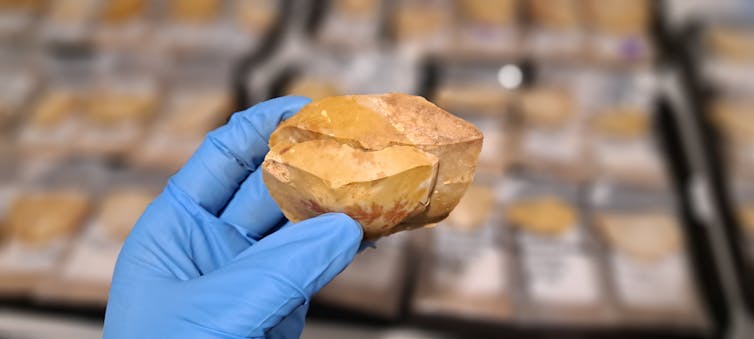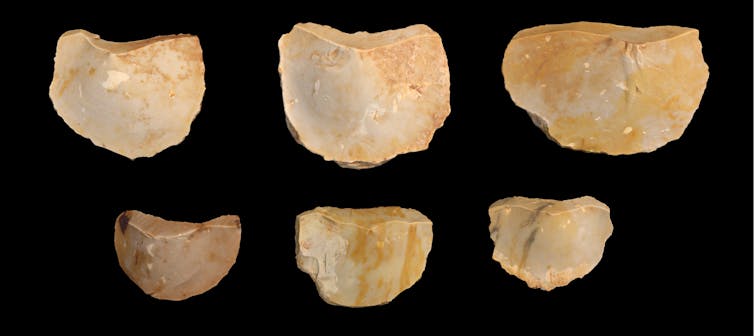- Home
Edition
Africa Australia Brasil Canada Canada (français) España Europe France Global Indonesia New Zealand United Kingdom United States Edition:
Global
Edition:
Global
- Africa
- Australia
- Brasil
- Canada
- Canada (français)
- España
- Europe
- France
- Indonesia
- New Zealand
- United Kingdom
- United States
 Academic rigour, journalistic flair
Academic rigour, journalistic flair
 Author provided
We found a cache of rare Aboriginal artefacts, telling a story of trade and ingenuity
Published: November 27, 2025 11.25pm GMT
Yinika L. Perston, Griffith University, Lorna Bogdanek, Indigenous Knowledge, Lynley Wallis, Griffith University
Author provided
We found a cache of rare Aboriginal artefacts, telling a story of trade and ingenuity
Published: November 27, 2025 11.25pm GMT
Yinika L. Perston, Griffith University, Lorna Bogdanek, Indigenous Knowledge, Lynley Wallis, Griffith University
Authors
-
 Yinika L. Perston
Yinika L. Perston
Research Fellow, Griffith University
-
 Lorna Bogdanek
Lorna Bogdanek
Indigenous Knowledge Holder, Indigenous Knowledge
-
 Lynley Wallis
Lynley Wallis
Professor, School of Humanities, Languages and Social Science, Griffith University
Disclosure statement
This research was partially funded by the following research grants awarded to Yinika L. Perston: the Griffith University Postdoctoral Fellowship Scheme (2023-2025) and the Berndt Research Foundation ECR Grant (University of Western Australia).
Lorna Bogdanek is affiliated with the Pitta Pitta Aboriginal Corporation.
Lynley Wallis receives funding from the Australia Research Council. She is affiliated with the Australian Association of Consulting Archaeologists Inc. and Wallis Heritage Consulting Pty Ltd.
Partners
Griffith University provides funding as a member of The Conversation AU.
View all partners
DOI
https://doi.org/10.64628/AA.5d9hjcjv5
https://theconversation.com/we-found-a-cache-of-rare-aboriginal-artefacts-telling-a-story-of-trade-and-ingenuity-269282 https://theconversation.com/we-found-a-cache-of-rare-aboriginal-artefacts-telling-a-story-of-trade-and-ingenuity-269282 Link copied Share articleShare article
Copy link Email Bluesky Facebook WhatsApp Messenger LinkedIn X (Twitter)Print article
About 170 years ago, a bundle of stone tools was deliberately buried, or “cached”, near a waterhole in far-west Queensland and never recovered. Why?
Our team’s investigation of this extremely rare site has revealed a long story of Indigenous trade and innovation in the Australian outback.
The bundle
We excavated the site in 2023. A handful of stones poking out of the soil turned out to be a pile of 60 large Aboriginal stone “tulas”, deliberately cached just north of Boulia in far western Queensland.
 The cache as it was found, before our excavation began.
Yinika Perston
The cache as it was found, before our excavation began.
Yinika Perston
 The cache during our excavation.
Yinika Perston
The cache during our excavation.
Yinika Perston
We used scientific methods to analyse the tools, working closely with the Pitta Pitta, who hold Native Title for this place, and with approval from the station property owners.
A tula is a Wangkangurru word (from the Munga-Thirri/Simpson Desert) for a special flaked-stone tool that would be hafted onto a handle and used for woodworking. They were important tools, used across most of the continent to make objects such as boomerangs, wooden coolamon dishes, shields and clapsticks.
 An ethnographic example of a stone tula hafted to a wooden handle with a lump of spinifex resin.
Mary-Anne Stone, CC BY
An ethnographic example of a stone tula hafted to a wooden handle with a lump of spinifex resin.
Mary-Anne Stone, CC BY
A land of fire and flood
This region’s climate is harsh. Even while we were excavating, bushfires raged to the north, preventing some of the team from joining us. Once we found the cache we knew were were in a race against time to recover the tools before they were washed away in the next flood.
Even when it doesn’t rain in the region, heavy rains in the north flow through the waterways towards Lake Eyre and slowly cover the land in a sea of brown water. After the floods, it dries again, until only the deepest pools hold any water.
 A drone image of the excavation site.
Yinika Perston
A drone image of the excavation site.
Yinika Perston
The Pitta Pitta people built stone-based shelters as protection from the sun and winter winds. Innovation and connection helped them survive the region’s harsh climates. If they could not find resources locally, they bartered along vast trade routes.
Written and archaeological evidence shows traded goods included stone axes, ochre, pearl shells and more. People also traded a native tobacco called pituri – of which a couple of pounds was reportedly so valuable it could buy “two wives, husbands or many goods”.
It’s also reported that unhafted tulas were exchanged, so it’s possible this cache was a bundle of specially made artefacts that were intended for trading.
The European invasion in the late 1800s was particularly brutal in this area, and disrupted many traditional practices. In Queensland, the Native Mounted Police were state-sanctioned forces sent to control Aboriginal people. At times they used extreme violence against men, women and children, and committed multiple massacres.
The abandoned remains of the Burke River Native Mounted Police camp is only about ten kilometres away from the cache site.
Read more: How unearthing Queensland's 'native police' camps gives us a window onto colonial violence
A uniquely familiar find
Incredibly, this isn’t the first time such a site has been found. In 1988, the year one of us (Yinika) was born, an archaeologist excavated a bundle of stone tulas less than eight kilometres from the one we worked on.
This discovery was unique, and provided priceless scientific data. But as an isolated find, the archaeologists were unsure whether the cache was a fluke, or evidence of a cultural practice. There was nothing else quite like it – until now.
The 1988 cache was similar to this one, but also different. It held 34 tulas and 18 other stone artefacts called flakes and retouched flakes, some of which might be unfinished tulas.
The more recent cache held nothing but 60 particularly large tulas, all of which were complete. Three pairs of the tulas in this cache fit back together, showing they were made at the same time and from the same piece of stone.
 Some of the tulas from this cache can be fitted back together.
Yinika Perston
Some of the tulas from this cache can be fitted back together.
Yinika Perston
It is now clear this caching practice was no fluke. Burying bundles of unused stone tulas was a repeated practice here.
Stories in the sand
Using scientific methods, we are trying to figure out when, how and possibly why these tulas were buried.
Quartz grains in the soil can be dated using a method called optically stimulated luminescence, or OSL. This technique uses decay rates in quartz to calculate when the grains were last exposed to sunlight.
Using this method meant we had to collect samples from the centre of the cache on a dark and moonless night, to avoid exposing them to any kind of light.
Dating specialist Justine Kemp then dated the samples and found a 95% probability the tulas were buried sometime between 1793 and 1913. For context, the nearby town of Boulia was established around 1879, and the Burke River police camp operated from 1878 to 1886.
The tulas may have originally been buried in a container of kangaroo skin, bark, woven strings, or even cloth if the owners overlapped with European pastoralists.
To test this, the surfaces were examined under high-powered microscopes by specialist Kim Vernon.
No traces were found, but this might be because organic plant and animal matter does not survive well in desert conditions. We hope to continue this line of research, to look for other microscopic traces that can tell us about the lives of these tools.
 3D models of some of the cached stone tulas.
Mary-Anne Stone, CC BY
3D models of some of the cached stone tulas.
Mary-Anne Stone, CC BY
We think the Pitta Pitta ancestors were likely planning to trade the tools in these caches when the time came, but for some reason never recovered them. Perhaps this was due to disruption caused by European arrival – but the dates aren’t precise enough to be sure.
The findings reveal how planning, resource management and collective cooperation allowed Aboriginal people to not only survive, but thrive, in this land of fire and floods.
You can view 3D models of the entire cache here.
- Research
- Archaeology
- Culture
- Aboriginal history
- Stone tools
- Excavation
- Aboriginal culture
- cultural artefacts
- Aboriginal customs
Events
Jobs
-
 Senior Lecturer, Human Computer Interaction
Senior Lecturer, Human Computer Interaction
-
University Lecturer in Early Childhood Education
-
 Case Specialist, Student Information and Regulatory Reporting
Case Specialist, Student Information and Regulatory Reporting
-
 Lecturer in Paramedicine
Lecturer in Paramedicine
-
 Associate Lecturer, Social Work
Associate Lecturer, Social Work
- Editorial Policies
- Community standards
- Republishing guidelines
- Analytics
- Our feeds
- Get newsletter
- Who we are
- Our charter
- Our team
- Partners and funders
- Resource for media
- Contact us
-
-
-
-
Copyright © 2010–2025, The Conversation

 Senior Lecturer, Human Computer Interaction
Senior Lecturer, Human Computer Interaction
 Case Specialist, Student Information and Regulatory Reporting
Case Specialist, Student Information and Regulatory Reporting
 Lecturer in Paramedicine
Lecturer in Paramedicine
 Associate Lecturer, Social Work
Associate Lecturer, Social Work


